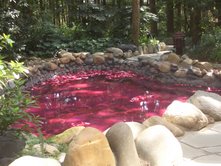
 God Bless You, Chinese Rosewater
God Bless You, Chinese Rosewater
Anning, one hour southwest of Kunming in southwest China, is a hot springs town. It is sleepy and certain of this theme. Walking around the green hills, there are signs everywhere: stone-bottomed hot springs, mud-bottomed hot springs, a hot springs hospital, even a hot springs Communist Party office – an enormous, ivy-covered mansion.
In a town full of hot spring possibilities, we decide on Jinfang Senlin Hot Springs, up a winding, forested hill. Though the springs in Anning have existed for thousands of years, Senlin opened in 2002. It is the only Japanese-style one here. Whereas other locations in Anning, such as the Hot Springs Hotel generally charge by the hour, have facilities indoors and are private, this Jinfang Senlin Hot Springs is outside, with a strong emphasis on the atmosphere around the springs, not just the water itself.
As with any place in China, advertising the word “Japanese” can be risky for business. The old name, “Rishi Senlin Wenquan” or “Japanese-style Forest Hot Springs” still appears on the older signs around the grounds, but “Jinfang Senlin Wenquan” or “Golden Direction Forest Hot Springs” now graces their brochures.
Wu Zhanmei, a pleasant hostess at Senlin, confirms our suspicious. “It was the politics, we had to change the name.” Wu Zhanmei greets us in the lobby and pours over the various hot spring packages: 88 RMB for a day of hot springs, 118 RMB to add a foot massages and 188 RMB (notice the price jump) to add something called “flirtatious expressions,” weight-loss treatment. This is an oil massage method, by which the masseuse (presumably with flirtatious expressions), will massage the fat out of your stomach or legs. Hmm.
We settle for a simple trip to the hot springs, plunk down a 300 RMB deposit (for two) and are given locker keys. The facilities at Senlin are very nice, not just by Chinese resort standards – clean (but not white-tile-and-halogen-light-sterile) locker rooms, crisp towels and robes, a sauna, powerful showers and name-brand toiletries.
The first thing we see walking out onto the grounds are soaring pine trees, straight as telephone poles. Birds dart overhead. Stone foot paths weave around the swimming pool and into the forest downhill toward the springs. In fact, all of Senlin is on the side of a hill, which adds a feeling of exploration to the place. Though it gets between 400 to 500 visitors every week, at one o’clock on Friday afternoon, there are only a handful of older Chinese men wading near the bar.
What kind of people visit a place like Senlin? “There are many people from Kunming, also Shanghai, mostly rich people,” Wu Zhanmei tells us. More and more foriegners visit every year. “A majority of them are Korean.” And what about Japanese visitors? “Japanese?” she pauses for a second with a deft smile, looking at my tape recorder. “Japanese, I’m not too clear about.”
Although the hot springs at Senlin are shared, there are enough of them (around 20) to allow for relaxing privacy. Other visitors are generally polite. They also don’t want to share a hot spring that’s occupied. On the other hand, they may be repulsed by the prospect of sharing bathwater with a waiguoren, the all-purpose word for anyone non-Chinese.
Each hot spring is a different size and shape, but generally shallow (three feet deep), and it can hold a dozen people comfortably. The temperature ranges between 36 and 46 Celsius, so finding a suitable comfort range is not difficult. Hot water seeps out of rocks at one end making it warmer than the far end. The water is spotless and constantly being cleaned.
One spring is dyed fushia with scented rose petals floating on the top. One has murky, therapeutic “milk". There are still typical Chinese tourism touches. One spring is flavored like sour apple candy, music is piped in from fake rocks, workers stare at the waiguoren as he hangs his robe on a bamboo pole. But on the whole, the place feels very far from Kunming, very far removed from other Chinese tourist locales. It feels…a bit…well, Japanese.
We hop springs for a while as our fingers prune – heads leaning back, eyes closed. Hours slip by and, wonderfully, nothing really happens. A few more people arrive, a few people leave. The evening air starts to chill – wet hair gets cold.